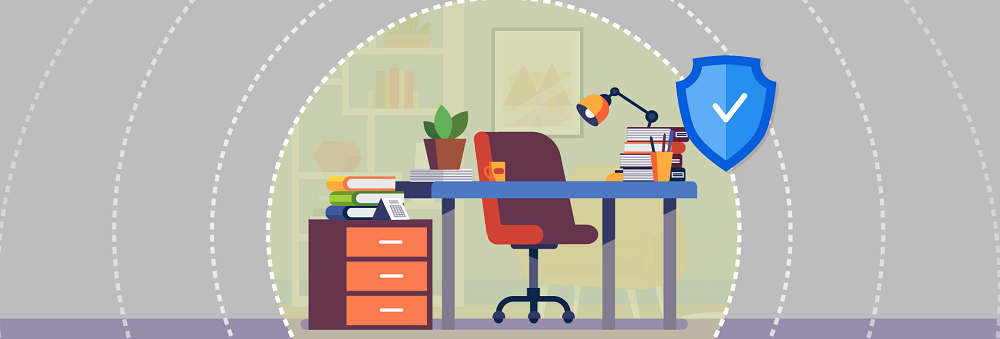Workforce Going Remote: Challenges for IT Team
Feb 14, 2018 | 42Gears Team
With more and more employees expecting the convenience of working from home, organizations are increasingly offering remote work opportunities as a selling point on a job advert. Fast network connections and identical connectivity experience are driving the work-from-home trend.
In fact, even World Economic Forum called remote working as a driving force behind transformation in workplace architecture. Already a majority of enterprises in the UK are allowing their employees to work from home.
What are the benefits of remote work?
Rise in Productivity
One of the biggest reasons why organizations are allowing employees to work from home is because it is often seen to improve productivity of the workers. Employees working from home generally do not spend time on usual office distractions such as impromptu meetings or coffee/smoking breaks.
Save on Infrastructure Cost
Allowing employees to work from home can also reduce the expenses related to office space and associated infrastructure cost. Having a workforce that primarily works from home or other remote locations can help companies save on bricks and mortar expenditure.
Employee Satisfaction
Employees are generally more happier when they work from home. High level of employee satisfaction will mean lower attrition rate. Employees nowadays consider the ability to work from home as an attractive work perk. Digitization allows employees to harness the flexibility that is offered by technology, enabling them to work from wherever suits them.
Work Life Balance
Having the option to work from home provides employees the flexibility to manage a stable work-life balance. Employees with responsibilities like childcare are more likely to continue working for an enterprise if they can work from home.
What could be associated risks and how to avoid them?
Simply letting the staff access the business network from home, could increase the chances of the business systems and networks getting infected by a virus through the employee’s laptop or computer. Before adopting a work-from-home practice, organizations need to invest in certain secured technologies to safeguard against cyber-attacks and data loss threats.
The first step in this process is to use two-factor authentication technique, which often includes a password and a unique, temporary code.
The second step is to encrypt the data exchanged between employee devices and the organization servers using IPSEC with DES or 3DES.
And the third step is to ensure that employees follow a practical password complexity rule that’s easy to remember but not easy to crack.
Evolution of Work-From-Home Technologies
In recent years, there has been an increase in demand for technologies that allow remote workers to access business information securely. The IT department is simply not equipped anymore to secure each and every device that remote workers use.
Cloud-based desktop or Desktop-as-a-Service (DaaS) solutions have been a popular choice for organizations to control their remote workforce. Enterprises can subscribe and provision virtual desktops and applications directly from a cloud-based virtual client computing (VCC) provider. Such kind of solutions allow users to work without installing applications on their remote devices. They are an excellent way to prevent viruses from getting transmitted via the user’s device to the corporate network. The problem with these solutions is that the users were unable to work every time there is a connection error or when they go offline.
An alternate to this solution was to provide access to all the files through a web server using a browser. This was a feasible option as most devices now offer web browsing with SSL (Secure Sockets Layer) protocol which will allow organizations to establish an encrypted link.
Turning Towards Enterprise Mobility Management
With large scale adoption of remote work across all industry verticals, enterprises started looking for technologically advanced options that allow secure working from any part of the world. Enterprises have been using Enterprise Mobility Management (EMM) technology for a few years now to manage and secure all business devices used by its mobile workforce. It has also helped organizations that have adopted BYOD strategies to reduce costs and improve mobile workforce opportunities. Therefore, it was quite natural for enterprises to turn towards EMM technology to help them streamline remote work strategy as well.
SureMDM by 42Gears is an intuitive and powerful enterprise mobility management tool that helps to secure, manage and monitor business mobile devices, running on Android, iOS, and Windows platforms. It can setup devices with necessary apps and settings, provision with Wi-Fi, email and VPN settings and even send alerts on device health and security. SureMDM can secure devices by configuring VPN settings remotely, allowing the employees to access email and enterprise-related applications on their laptops. The solution supports desktops/laptops and smartphones running on Windows 10 operating system, having Pro Ent Edu Mob MobEnt editions.
SureMDM can monitor devices remotely as well as track them on map in real-time. Enterprises can also remotely lock and wipe devices as well as apply password policies.
Looking to mobilize and secure remote workforce? Click here for SureMDM free trial.
Subscribe for our free newsletter

